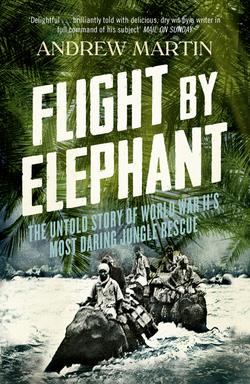Читать книгу Flight By Elephant: The Untold Story of World War II’s Most Daring Jungle Rescue - Andrew Martin - Страница 17
The Footprint
ОглавлениеIt was cold at dawn in the jungle on 1 June, and still raining. Leyden was definitely not at all well, and he kept insisting that Millar go on without him. ‘I was unsympathetic,’ Guy Millar wrote, ‘and even uncouth, I’m afraid.’
With the rising sun came heavier rain. There was no food for breakfast, so Millar lit a cigarette and he made a decision: he and the young elephant tracker, Goal Miri, would make a last dash for a village, while Leyden and the Kachin porters would come through at their own pace.
The two set off, marching all day ‘at a hard pace’ through thick jungle, and making tree cuts – incisions in the bark – on the way so that Leyden and the Kachins might follow. Eventually they came to what Millar called ‘a small river, the Debawng’. But the Debawng, or Debang, river is small only by the standards of upper Assam. It occupies a gorge about 200 yards wide. In the dry season, a few shallow streams – each as wide as an ordinary English river – meander through the white rubble of the river bed. In the monsoon, things are different: Millar and Leyden were staring at white rapids. It was probably shallow enough to wade through, but there was the question of tree cuts. How would the following Kachins and Leyden know where they resumed on the opposite bank? At four o’clock, the rain stopped. In two hours, it would be pitch dark. Millar contemplated the river, then he looked at the red mud of the riverbank, and he saw a footprint.
At first, he didn’t point it out to Goal. He just sat and stared at it: ‘… the first signs of man for nineteen days over a journey of a hundred miles.’
It was not a boot print, but a footprint. It pointed left, in the direction of the bigger river towards which the Debang was flowing, in other words the Noa Dehing, the river that Millar and Leyden had been shadowing all along, and whose tributaries they had been crossing, and falling into. Millar pointed out the footprint to Goal Miri; they lit a bamboo fire as the light faded.
A fire ought to go with food, but there was none. After an hour or so, they heard the sound of twigs snapping in the jungle. That meant people. Animals did not break twigs as they walked. The beam of an electric torch shone through the trees: Leyden and the porters had arrived. Leyden could hardly walk, and seeing Millar by the river he lay down immediately. Millar wrote, ‘The pangs of hunger were now acute. The [porters] sat around glaring at each other, thinking, I suppose, the end was in sight.’ Nobody seemed very impressed by the footprint. After a while, the Kachins made flares of burning grass. They took these to the water’s edge in order to hunt for crabs – which they did not find. When they had left his immediate vicinity, Millar realized he could still see the footprint quite clearly. Moonlight. The moon was full –
